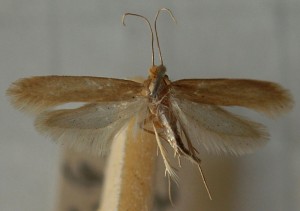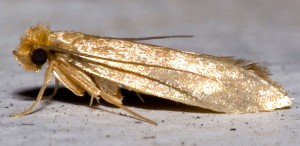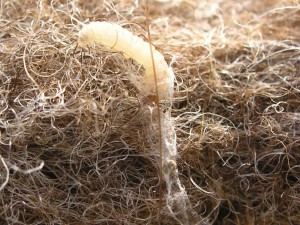Facts About Clothes Moths
Occurrence: The common clothes moth (Tineola bisselliella) and the case-bearing clothes moth are the most widespread pest moths in the UK. Originally from warmer regions, it is believed that they have been present in the UK since at least Roman times.
Diet: It is the larvae of the clothes moth that cause damage, feeding on animal products such as wool, fur, silk, feathers, and hair. They may also attack synthetic materials and plant fibres.
Control: Since clothes moths thrive on animal textiles, this is where they must be tackled. The process involves inspecting and cleaning all infested fabrics. If the problem recurs, all textiles in the home should be cleaned. Read more about controlling clothes moths below.
Controlling Clothes Moths
The best method for eliminating clothes moths is to remove all eggs and larvae. As they live in textiles, all infested fabrics should be cleaned. If moths are a persistent issue, or if the infestation is severe, all textiles in the home should be cleaned.
If you encounter adult moths, kill them immediately to reduce their population. Treat textiles as follows:
- Smaller items like clothing, bedding, and linens should be machine-washed at a minimum of 50°C. You can also freeze textiles at -18°C or lower for 48 hours. Alternatively, heating them (e.g., in an oven) at 60°C for one hour is effective.
- Larger items like rugs, curtains, and duvets should be dry-cleaned professionally. Rugs can also be beaten, brushed, and vacuumed, but dry cleaning is more effective.
- Upholstery fabrics such as furniture coverings should at least be beaten and thoroughly vacuumed. In freezing weather, place furniture outside overnight and bring it back indoors during the day for 48 hours. This alternating heat and cold will kill any eggs, larvae, or moths.
To prevent future infestations, consider storing rarely used clothing in tightly sealed plastic or paper bags. Hanging moth deterrent sachets in wardrobes and placing them in drawers is another effective measure.
Signs of Moth Infestation
Clothes moths lay their eggs on animal products like wool, fur, silk, feathers, and hair, and prefer dirty fabrics to clean ones because their larvae require moisture (larvae do not drink water).
Look for signs of infestation by checking for larvae cocoons. These are usually found on organic textiles that are infrequently used and not entirely clean, such as clothes in wardrobes, rugs, curtains, and upholstery. On clothing, cocoons often appear in folds or areas where the fabric overlaps, like rolled-up sleeves or collars.
In addition to cocoons, textiles may show visible damage such as deep marks (where the larvae have chewed) or even holes. Larvae and eggs are difficult to spot, but their droppings—which many mistake for eggs—are easily seen with the naked eye. They are white and round. Larvae are easier to detect than eggs.
If you see adult moths scurrying away when disturbed, they are likely clothes moths. Always kill any adult moths you find.
Description of Clothes Moths
Adult Clothes Moths
Clothes moths are approximately 0.5 to 0.9 cm long with a wingspan of 0.9 to 1.6 cm. Their wings are golden and fringed with long, fine hairs. The head is covered in reddish or bronze-coloured hairs.
Both male and female moths are light-averse, so their presence may not be noticed immediately. Adult clothes moths tend to run rather than fly when disturbed, though males are more likely to fly than females. If you see a flying clothes moth, it is likely a male.
Clothes moths can easily be confused with case-bearing clothes moths, as they are similar in size and appearance. However, case-bearing clothes moths are slightly browner and have three black spots on each wing, though these spots may wear off over time.
Clothes Moth Larvae
Newly hatched clothes moth larvae are very small, and fully grown larvae are usually 8 to 10 mm long. In some cases, fully grown larvae can reach up to 13 mm.
Larvae are whitish to pale yellow (often cream-coloured) with brown or dark heads.
They initially live freely on their food and later in individual cocoons made of their silk, droppings, and parts of their food source (e.g., fur, fabric). The larvae spin their cocoons on their food source and feed from it. They can turn within their cocoons to feed from either end without altering the cocoon’s position.
Clothes moth larvae generally feed only on animal products such as wool, fur, silk, feathers, and hair. However, they can also consume synthetic materials and plant fibres (e.g., cotton) if their food supply runs out. This may happen if the synthetic or plant materials:
- Block access to animal products (e.g., a feather-filled jacket surrounded by synthetic fabric)
- Are mixed with animal materials (e.g., a jacket made of half wool and half cotton)
- Contain body oils (e.g., laundry or worn but unwashed clothing)
Unlike case-bearing clothes moth larvae, clothes moth larvae do not wander but may leave their cocoons to find new food sources. They also leave when they mature.
Clothes moth larvae are often found under overlapping clothing layers, such as collars or folded sleeves. Like adult moths, they avoid light and will seek darkness when exposed to light.
Read more about other moth larvae here.
Life Cycle
Female moths generally live very short lives – typically 3 to 16 days after laying eggs. Males live slightly longer, but no more than one month.
The clothes moth’s life cycle unfolds as follows:
- Eggs: The female lays 30 to 200 eggs*, which stick to textiles that will become the larvae’s food. Eggs typically hatch in 4 to 10 days during the summer, but it can take up to 3 weeks or longer (even months) in the winter.
- Larvae: The larval stage lasts between 50 and 200 days, during which the larvae feed on textiles and grow until they are ready to pupate.
- Pupation: The pupation stage lasts 10 to 50 days, during which the larvae spin a cocoon and pupate inside.
- Adult Moth: Once the pupation stage is complete, the adult moth emerges from its cocoon. Clothes moths typically mate and lay eggs within 1 to 2 days of emerging.
*The amount of eggs varies in several sources and our figures are the minimum and maximum of all sources.
The total development time, from egg to adult moth, usually takes between 2 and 3 months, though it can extend to over a year in some cases. The number of generations per year depends on the home’s temperature and humidity, with a maximum of 4 generations.
Read more about the moth life cycle here.
History of Moths That Attack Clothing and Textiles
Although moths that attack clothing and textiles (ie. clothes moths and case-bearing clothes moths) are now common pests in British homes, these moths are not native to the UK.
They originated in the warmer parts of Eurasia. It is believed that they have been present in the UK since at least Roman times. As in many parts of Europe, they have become more prevalent when tiled stoves became common in homes. The efficient heating provided by these stoves allowed clothes moths to thrive.
From the early 19th century to the early 20th century, clothes moths were a significant problem in British homes, largely due to a combination of adequate heating and damp conditions in homes, as well as the prevalence of woollen clothing, which provided ideal conditions for moths. At the time, people used mothballs containing naphthalene, which have since been removed from the market due to concerns that they may be carcinogenic.
Since the mid-20th century, clothes moth populations have declined, possibly due to the following factors:
- Better moth repellents, particularly treatments for furniture and home textiles
- Reduced humidity in homes
- The use of vacuum cleaners, which effectively remove eggs and larvae of some moth species
- Less wool clothing and the increased use of synthetic materials
Additionally, there is more knowledge about moths and moth control today, and this information is more accessible, which likely also helps to limit the problem of these moths.



